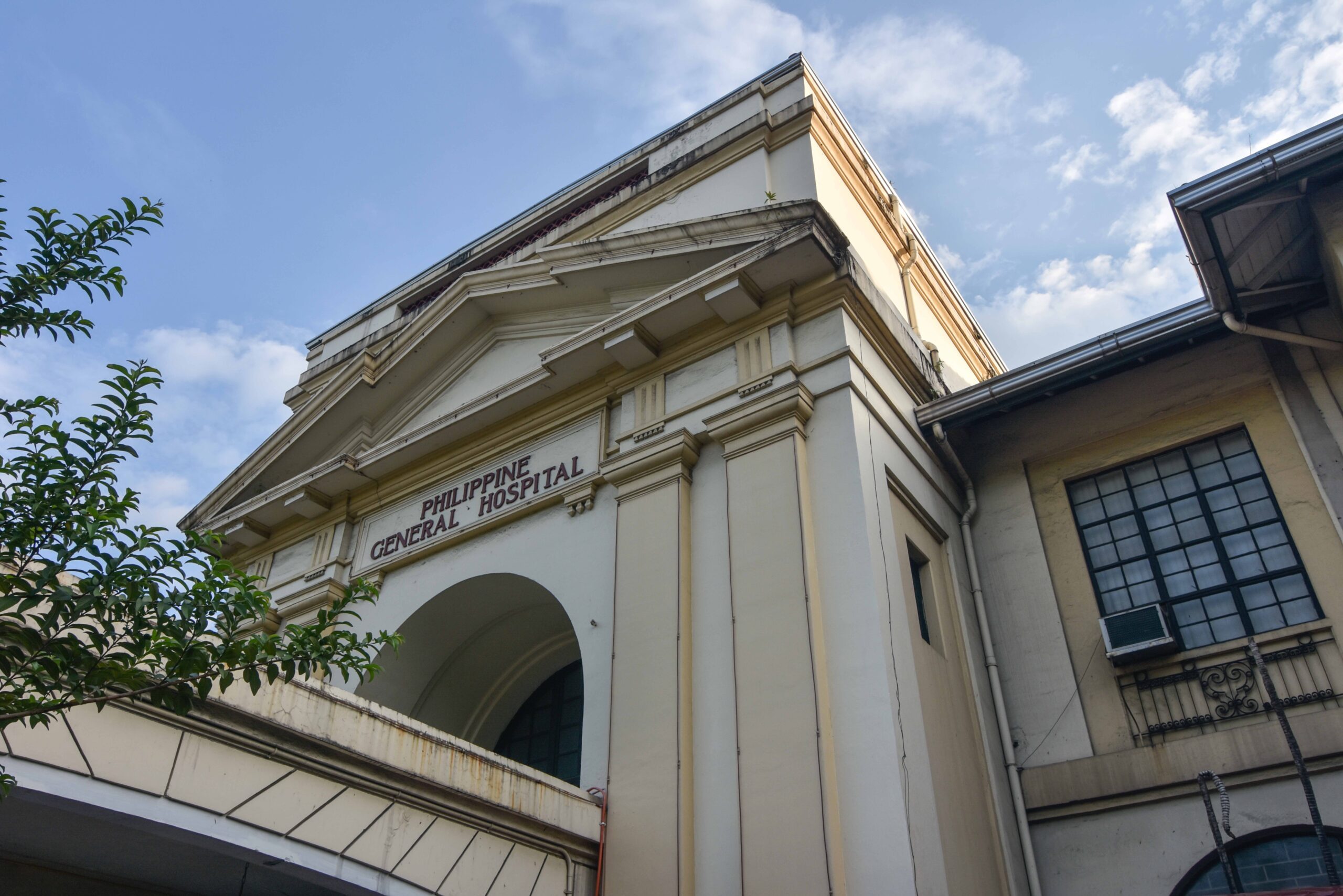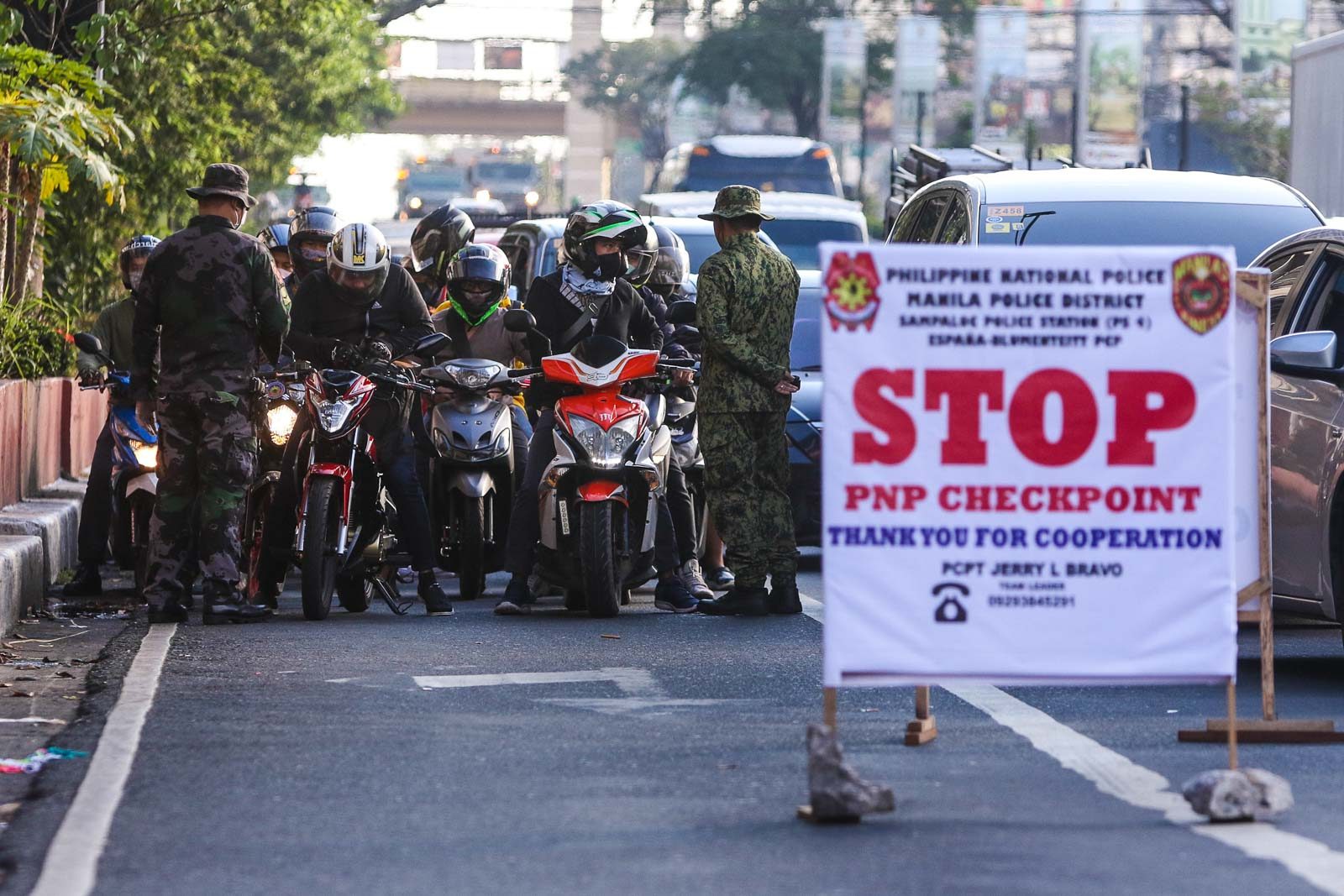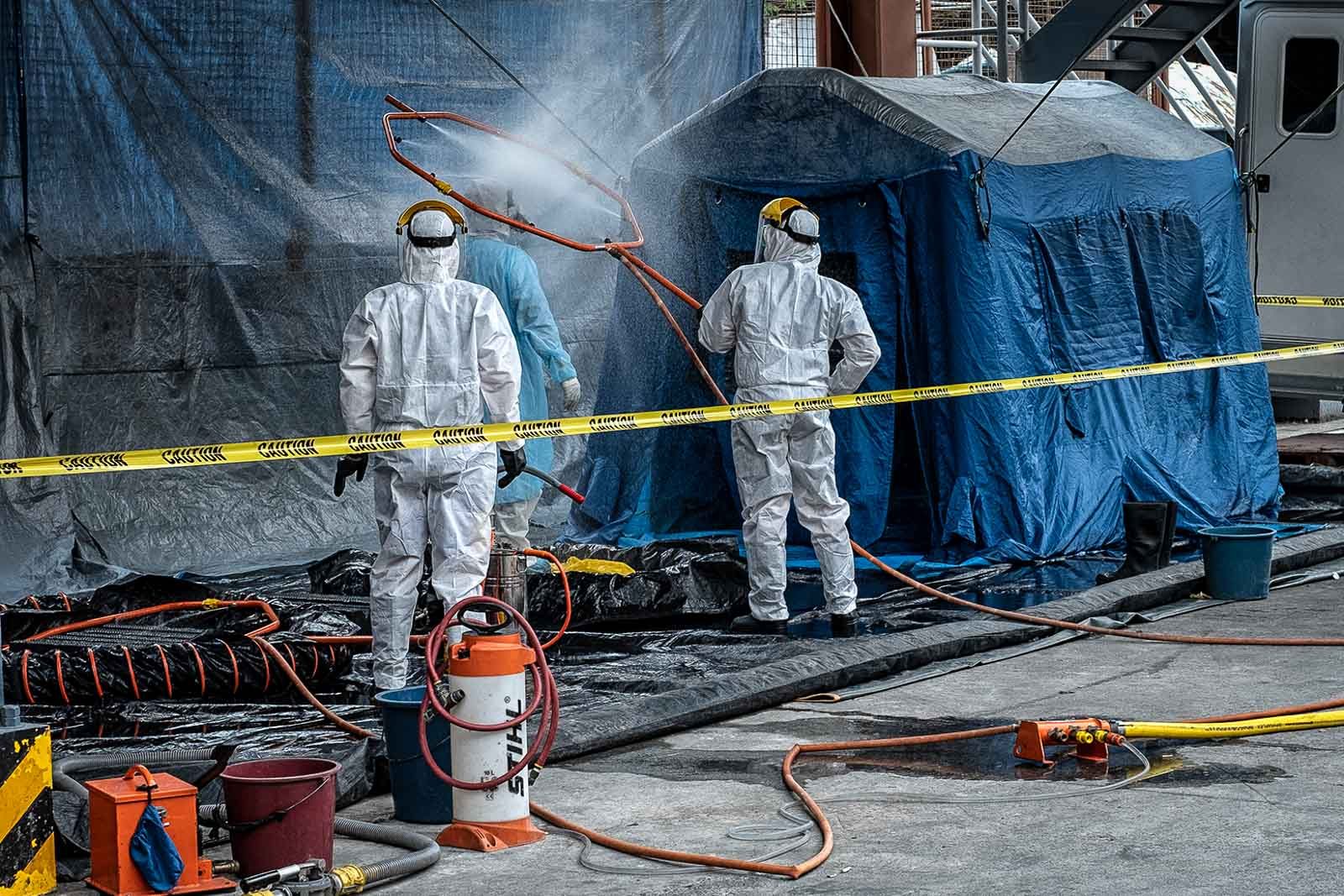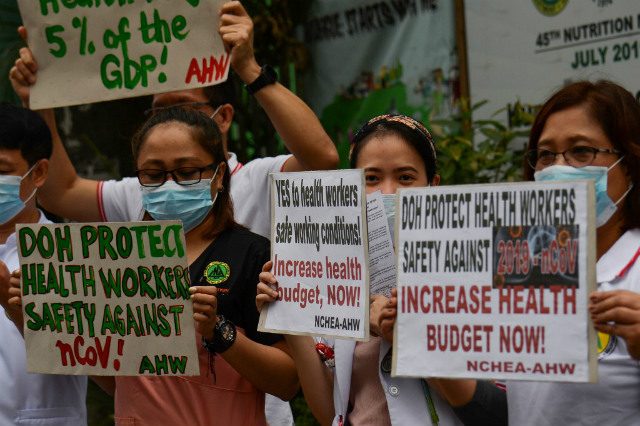SUMMARY
This is AI generated summarization, which may have errors. For context, always refer to the full article.

MANILA, Philippines – A normal day for nurse Cristy Donguines starts with a two-hour commute from her Bulacan home to her workplace in Sta Cruz, Manila.
In different and much calmer times, the long travels in the past 17 years to and from the government-run Jose R. Reyes Memorial Medical Center (JRRMMC) were already part of her daily sacrifice.
But with the outbreak of the novel coronavirus in the Philippines and the subsequent lockdown of Metro Manila and the island of Luzon, Cristy also has to contend with the daily risk of being infected. After all, having to take 6 public utility vehicles each day just to reach her destination and get back home exposes her to these risks.
Cristy said she does not want to harm herself, her loved ones, and patients at the 75-year-old hospital, many of them coming from Manila’s poorest communities. As of Monday, March 16, there has been no confirmed case in their hospital just two minutes away from the Department of Health (DOH) headquarters.
But self-quarantine – usually lasting 14 days – is almost out of the question, given the already thin workforce and the vague assurances of assistance from no less than the DOH. There’s little comfort, aggravated by the measly salaries of government nurses that range from P19,000 to P25,000, depending on salary grade.
“Walang malinaw na alituntunin regarding sa leave credits kung ma-quarantine kami,” she said. “Walang sinasabi kung ito po ba ay ibabawas sa current numbers namin o hindi. Paano kung mag-positive kami?“
(There are no clear guidelines regarding our leave credits if we go on self-quarantine. They don’t tell us if it’s going to be deducted from our current number or not, What if we get the virus?)
At JRRMMC, where there are 485 doctors and 366 nurses, hospital staff have also been asked to improvise with their protective gears.
Cristy said they were told to transform cloth like linen into face masks, even if there has been no evidence of it being a sufficient protection against the virus. Still, it’s better than wearing nothing while dealing with patients every day.
“Kami na ang hahanap ng paraan kasi iyong government, hanggang salita ang ginagawa nila, hindi sila gumagawa ng action para bigyan kami ng sinasabi nilang sapat na supply,” Cristy said. (We are the ones looking for ways to address the problem because the government, they’re all talk, they don’t do anything to give us enough supply.)
“Paano kung magkasakit kami, paano iyong pamilya namin, makakasigurado ba kami na mapapakain sila ng tatlong beses sa isang araw?” she said. “Hindi naman makatarungan ito.“
(What if we get sick? How about our families? Are there assurances from the government that they will be fed 3 times a day? This is not fair.)
Cristy, unfortunately, is not alone in her predicament; nor is her experience unique. Health workers on the frontlines across the Philippines are put in a perilous situation where compromise and sacrifice are the name of the game, for the benefit of the public they serve.
Philippine General Hospital
A little over 5 kilometers away from JRRMMC is the Philippine General Hospital (PGH), one of the country’s largest government health facilities, where long lines at the outpatient department or the crowded emergency room and wards are a common sight.
PGH, after all, is where many of the country’s indigents flock to, braving long commutes from their provinces to get much needed medical assistance. On average, the PGH outpatient department sees around 3,000 patients a day. On an annual basis, the hospital services at least 600,000 to 800,000 patients.
On Tuesday morning, March 17, nurse Marie (not her real name) finished her 12-hour overnight duty and stepped out into a city where mass transportation is prohibited, in accordance with the enhanced community quarantine that President Rodrigo Duterte declared the day before.
It had been a long night for Marie, who handles patients under investigation (PUIs) for novel coronavirus at PGH. She is one of the only 3 nurses per 12-hour shift in her group that receives patients referred to by the ER staff.
As of posting, PGH has had one confirmed case, 8 admitted PUIs, and had already sent home 34 PUIs showing mild symptoms. That night, Marie handled a patient who tested negative.
She just wanted to go home and prepare until her next shift in two days. Yet the jeepneys and buses that normally traverse Taft Avenue and contribute to the usual traffic were nowhere to be seen.
Marie tried hailing cabs, as ride-sharing applications didn’t work, but not one wanted to give her a ride home out of fear of being apprehended by authorities. Philippine National Police Chief General Archie Gamboa had ordered the arrest of “disobedient” drivers.
Local government units were given the responsibility of setting up transportation for health workers in their jurisdiction. But during the first 7 hours of the lockdown, no help was in sight, at least at PGH.
Fortunately, before giving up hope and starting what could be a two-hour walk, a tricycle driver took pity and offered his services. But he could only take Marie until Welcome Rotonda, the border between Quezon City and Manila.
She held her breath throughout the 5.9-kilometer ride inside the clanky metal sidecar, through roads not normally meant for tricycles, away from the eyes of law enforcers.
“Hindi lang life ko ang at risk, pati ang buhay niya kasi sobrang delikado iyong ginawa namin, pero ang hirap na kasi, baka gusto rin kasi niya kumita (We placed both our lives at risk because it was very dangerous, but it’s so hard, and maybe he wanted income),” she said.
Getting home should have been the least concern for Marie, or any of the health workers. But the latest pronouncements of the national government that caused confusion among many Filipinos have been an added burden to the frontliners.
“Nagpapatupad sila ng protocols na walang proper guidelines (They implemented protocols without proper guidelines), we’re left and living in the dark,” she said. “We don’t know how we’ll get to work, how we’ll get home, and how we’ll be safe in between.”

Only line of defense
If the serious lack of proper guidelines wasn’t enough, public hospitals also have to face and deal with long-standing issues that should have been better handled by the national government.
The problems – from lack of basic medical supplies to understaffed health facilities – become all the more glaring and hard to ignore amid the novel coronavirus outbreak that is threatening the nation.
Marie recalled how during the first few days of the outbreak, fear was palpable among health workers in PGH buildings that had previously seen the horrors of World War II. There was a general lack of information on the novel coronavirus that had already affected thousands in several countries, especially China.
“After the news na sa floor namin na-admit yung isang PUI, it was scary,” she said. “We have general information about it pero iyong kung gaano katagal nag-stay sa air, parang sobrang limited ang information kasi bago pa iyong virus.”
(After the news that the first PUI was admitted in our floor, it was scary because we didn’t know how it was transmitted. We have general information about it but information on how it stays in the air, things like that, were so limited because the virus was still new.)
Aside from the vague protocols, especially on how to handle patients suffering from the virus, personal protective equipment (PPEs) were running low. Their supplies had been almost depleted in the aftermath of the Taal eruption.
In the beginning, they were given two face masks to be used for one week. Staff were eventually provided one box good for a week – at least 52 pieces to be shared by 3 nurses, two assistants, and one utility worker.
“Protection-wise, hirap na hirap na kami kasi (we’re having a really hard time),” she said. “We’re worried that we’ll get sick or we might bring home this virus.”
“We already are worrying about taking care of patients, tapos madadagdagan pa ng burden na hindi namin alam kung ang families ba namin ay safe at kung makakauwi ba kami sa kanila (Then there’s the added burden of making sure our families are safe and worrying if we’ll get home safe to them),” Marie added.
With PPEs running low, it’s still vague for many health workers at PGH how they’ll go on in the coming days, as the number of confirmed cases of the novel coronavirus is expected to rise.
“It’s very frustrating kasi walang guidelines, walang help from the government na nare-receive right now (no guidelines, no help from the government),” Marie said.
Mark (not his real name), a resident doctor at PGH who asked not to be named, said masks and alcohol are their “only line of defense at the moment.”
“We are grateful for those who have donated, but there still remains a shortage of the said materials,” he said, adding that full gowns and headgears are reserved for workers directly supervising people suspected of carrying the virus.
Some organizations have taken it upon themselves to address the problem government health workers are facing.
The student council of the University of the Philippines Manila, the institution that operates PGH, started a donation drive for health masks and other basic hospital needs. (READ: How to help healthcare workers, frontliners during coronavirus pandemic)

Not enough manpower
Beyond the lack of basic supplies, one glaring characteristic of the country’s healthcare system is the lack of manpower.
There are about 721 public hospitals, with at least 3,131 doctors and 5,975 nurses. Many of them are underpaid, compared to their counterparts abroad, with an entry-level nurse earning P15,000.
The current roster pegs the ratio of government doctors to population at 1:33,909 – far from the ideal 1:20,000 – and 1:17,769 for nurses.
“Some of our colleagues have fallen ill and are warranted to go on a 14-day quarantine, thinning out our workforce,” Mark said, adding that this has pushed residents to their limit.
On a normal day, there are about 10 nurses assigned at the PGH ER while the number of doctors varies, depending on the day’s load.
The management suspended its outpatient services to deploy some workers to other wards. It has also welcomed over 100 interns who volunteered, despite an earlier suspension of internship programs.
The mass transportation may lead to more problems, however. In fact, two of Marie’s colleagues were barred from crossing the QC-Manila border even if they showed their IDs. They were just told by authorities to walk the distance to PGH – a near-impossible task as much as it was ridiculous, especially under the heat of the sun.
In the end, they were left with no choice but to go home, possibly missing a day’s wage.
Helping themselves
In Quezon City, health department head Dr Esperanza Arias said that hospitals are augmenting their staff by pulling in personnel from other departments. They are filling in the slots left by those assigned to an isolated area where patients suspected of having the coronavirus are being held.
The city was also able to procure several PPEs before the threats of the virus increased in the metro.
“Sabi namin, kumuha na kami kasi (We said we should already get because) if we will not be able to use them now, we will still find use for it, in case,” she said.
Local governments outside Luzon are also preparing for a possible increase in confirmed cases.
Beyond Metro Manila
Dr Leonell Quitos is no stranger to the issues faced by government hospitals, having just completed his fellowship in Adult Infectious Diseases at PGH in 2019.
The 33-year-old is now on the frontlines as the only infectious diseases specialist in Iligan City in Northern Mindanao, doing his best – along with at least 300 doctors – to protect a population of at least 342,618 people against the coronavirus.
“Iyong problems noon, nakikita ko pa rin ngayon (The problems I saw then, I still see today),” he said.
As the city is placed under a state of calamity over its first confirmed case, Quitos and his colleagues are working double time to manage the situation, including a plan to set up a hospital solely for suspect cases.
On top of doing rounds, Quitos has been reaching out to officials to see their plans through.
He takes calls from colleagues and even the occasional media while driving to meetings – one of the few moments he’s free.
“Sama-sama natin tapusin itong problema (Let’s work together to end this problem), they will be properly compensated,” he added, urging doctors and workers to join them.
Megan (not her real name), a health practitioner also in Iligan City meanwhile, said doctors are trying to raise funds to be able to buy them in bulk for distribution to all health workers.
“The implication is the fear, especially if you don’t have masks or alcohol, some doctors are thinking of not holding clinic hours anymore, including those who are not working directly with departments against the virus but are still exposed nonetheless,” she said.

Too many lives at stake
There is much to be desired in the way the Philippine health system is handling the novel coronavirus outbreak, and the ball is in the court of the national government.
On Twitter, PGH consultant neurosurgeon Dr Ronnie Baticulon acknowledged that many health workers are afraid of what could possibly happen in the near future because they’ve seen this health care system let them down before.
“Too much, too many lives are at stake,” he wrote.
Marie of PGH will go on shift Thursday. To avoid more problems, she already asked help from her barangay, requesting a shuttle service to her hospital. But not all have the same cooperative and helpful local officials.
To address this, PGH started a carpool system. Dormitories have already been prepared for some health workers, though Marie admits that it will most likely not benefit all those in need.
But she said PGH is now handling the situation better than before, even without direct help from the national government.
For Cristy of JRRMMC, however, the following days don’t show reason for optimism.
“Ina-accommodate namin pa rin ang mga taong pumupunta sa ospital as much as possible, kahit kami mismo hirap na hirap na rin, kasi pasyente iyan eh na dapat bigyan ng treatment na nararapat sa kanila,” she said.
“Pero gustuhin man namin na ibigay ang lahat, hindi namin kayang kumilos na 100% kasi hindi sapat ang pangangailangan ng mga ospital.”
(We accommodate those who go to the hospital as much as possible, even if we’re having difficulty, because those are patients who need treatment. But even if we want to give them our all, we can’t do so 100% because hospital supplies are inadequate.)
Clearly they need help. – Rappler.com
TOP PHOTO: ISOLATION. Quezon City General Hospital health workers prepare the isolation tent for a person with suspected novel coronavirus. Photo by Darren Langit/Rappler
Add a comment
How does this make you feel?
There are no comments yet. Add your comment to start the conversation.